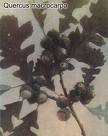Quercus Macrocarpa Tree Information
Images of Quercus Macrocarpa:






Quercus Macrocarpa grows in the following 37 states and provinces:
Alabama, Arkansas, Connecticut, Delaware, Illinois, Indiana, Iowa, Kansas, Kentucky, Louisiana, Maine, Manitoba, Maryland, Michigan, Minnesota, Missouri, Montana, Nebraska, New Brunswick, New Hampshire, New Jersey, New York, North Dakota, Ohio, Oklahoma, Ontario, Pennsylvania, Rhode Island, Saskatchewan, South Dakota, Tennessee, Texas, Vermont, Virginia, West Virginia, Wisconsin, WyomingInformation about Quercus Macrocarpa:
The Quercus Macrocarpa is commonly known as the Blue Oak, Bur Oak, Mossy-overcup Oak, Mossycup Oak as well as Scrub Oak.
The fully documented scientific species name is Quercus macrocarpa Michx. Widely recognized varieties are : Q. m. var. depressa (Nutt.) Engelm. Q. m. var. olivaeformis (Michx. f.) A. Gray Q. m. var. macrocarpa Bur oak is a member of the white oaks (Lepidobalanus) .. This subgenus is noted for widespread hybridization and many intermediate forms. Bur oak hybridizes with numerous species including northern pin oak (Q. ellipsoidalis), white oak (Q. alba), swamp white oak (Q. bicolor), overcup oak (Q. lyrata), swamp chestnut oak (Q. michauxii), chinkapin oak (Q. muehlenbergii), post oak (Q. stellata), live oak (Q. virginiana), and Gambel oak (Q. gambelii) .Bur oak is widely distributed throughout much of the north-central United States and the eastern Great Plains . It occurs from southern New Brunswick and New England westward to the Dakotas and southeastern Montana, and south to Texas, Arkansas, and Tennessee . Bur oak is locally common in Louisiana and Alabama . Quercus macrocarpa var. olivaeformis is largely restricted to Iowa, Minnesota, South Dakota, and North Dakota. Quercus macrocarpa var. depressa occurs mostly along the western margin of the Great Plains .Bur oak is an important dominant in many plant communities. Publications naming bur oak in habitat type, community type, or plant asociation classifications are: Classification of the forest vegetation of Wyoming Upland hardwood habitat types in southwestern North Dakota Upland forest and woddland habitat of the Missouri Plateau, Great Plains Province Forest vegetation of the Routt National Forest in northwestern Colorado: a habitat classification Plant assocaitions of Region 2: Potential plant communities of Wyoming, South Dakota, Nebraska, Colorado, and Kansas Composition and structure of the principle woody vegetation types in the North Dakota Badlands A classification of the Cercocarpus mantanus, Quercus macrocarpa, Populus deltoides, & Picea glauca habitat types of the Black Hills NF Some of the information provided here is attributed to:Tirmenstein, D. 1988. Quercus macrocarpa. In: Fire Effects Information System, [Online]. U.S. Department of Agriculture, Forest Service, Rocky Mountain Research Station, Fire Sciences Laboratory (Producer). , available at the USDA Fire Effects Information System (FEIS) website